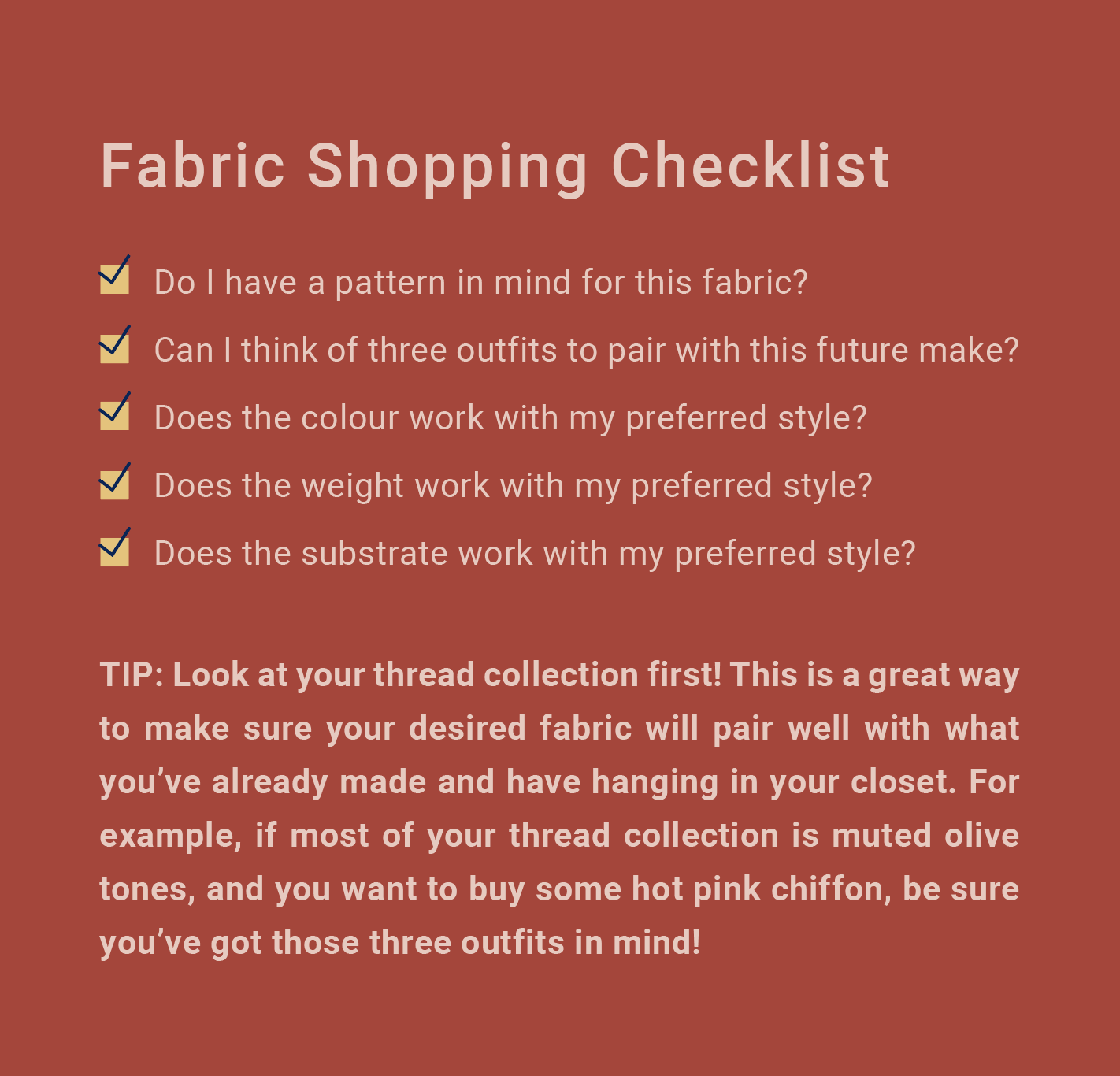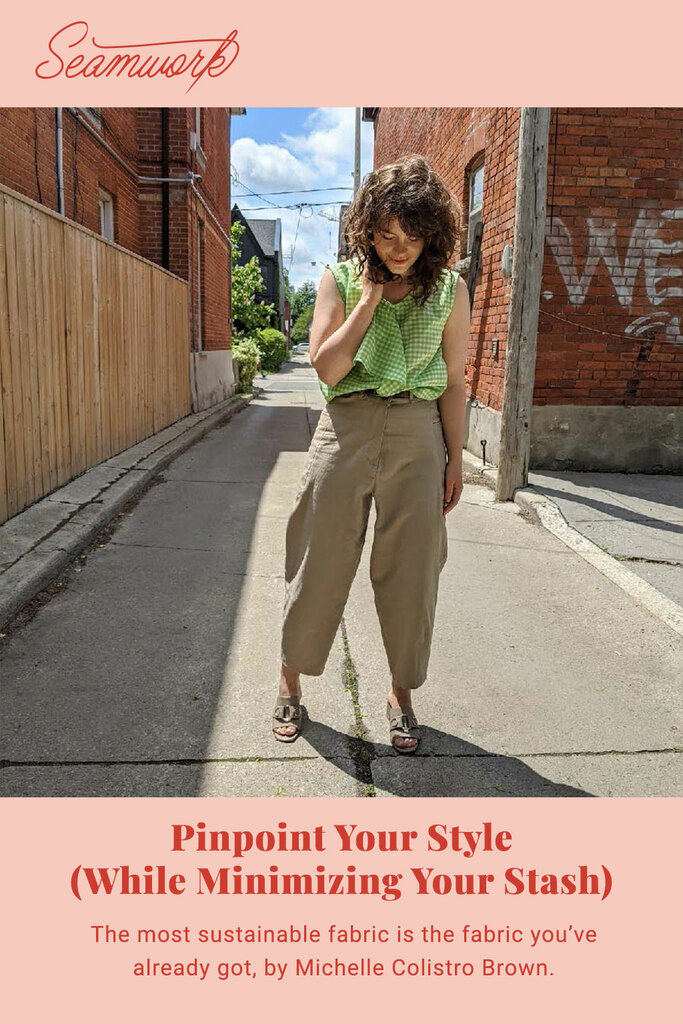We’ve all been there: a fabric store sends out its weekly mailer, and we can’t hit the buy button fast enough. We clear a spot for our impending bundle of joy on our fabric shelf before being toppled by an actual avalanche of chiffons, crepes and cottons. After bandaging our stash-inflicted wounds, we dream a little dream of what this new fabric will become. And dream. And, years later, keep dreaming. Because, as much as we were tempted by it initially, it just didn’t find its way into our living, breathing, actual wardrobe.
While we’re all tempted by new fabric offerings and want to support our treasured small businesses (thank you!), the most sustainable option is buying what you need, in the amounts you need, in colours, weights and widths that you know you’ll use. And then actually using what you bought. To get to the root of what works for you, you’ll need to do a bit of upfront studying, but it’s fun work, pinky promise. So grab an empty notebook and a fresh set of browser tabs, and let’s get started.
Organize and Analyze
Pull Up Your Inspiration
Okay, time to dig in. Open up your Pinterest and Instagram saves in a new window, alongside a brand new Pinterest board or fresh folder on your desktop—name it whatever you’d like! Next, drag over photos to your new board that exemplify your current style, or showcase what you’d like your current style to be—this could be a complete outfit, a unique piece, a colour palette or a pattern line drawing. No need to be too picky at this point; just notice what your eye is naturally drawn to.
Now, time to put on your analyst’s cap: take a look through your newly curated board and take notes on any commonalities. These can be shorthand and super off-the-cuff (think: “Wow, lots of baseball caps” or “I clearly love floral shorts”). This is your warmup and a good exercise to start honing your styling skills.
Sift Through Your Style
Much like a nugget of gold in a handful of sand, our perfect personal style is often hidden in a sea of outfits we feel not-so-great in. It’s not our fault: ever-shortening seasonal cycles in RTW clothing are constantly tempting us with new trends, and it’s hard to have a minute to breathe and ask ourselves if we actually like them. (I’m still trying to figure out how I feel about puffy sleeves.) Now’s the time to go through the notes you took in the previous step and dig a little deeper.
Find Your Fabrics
Take note of the fabrics found in your favourite outfits. Is your board overflowing with crisply-tailored oxford shirt dresses? Or do you favour floaty, flowy florals? Maybe you’re somewhere in between, gravitating towards a mixture of opposites (think boxy canvas jacket atop a long, flowy cocoon dress). We’ll get to colour in the next step, so just take notes on the types of fabric for now—think weight, substrate and amount of structure.
Tip: Create a subcategory in your board for looks that feature your favourite fabrics, or create a new list in your notebook.
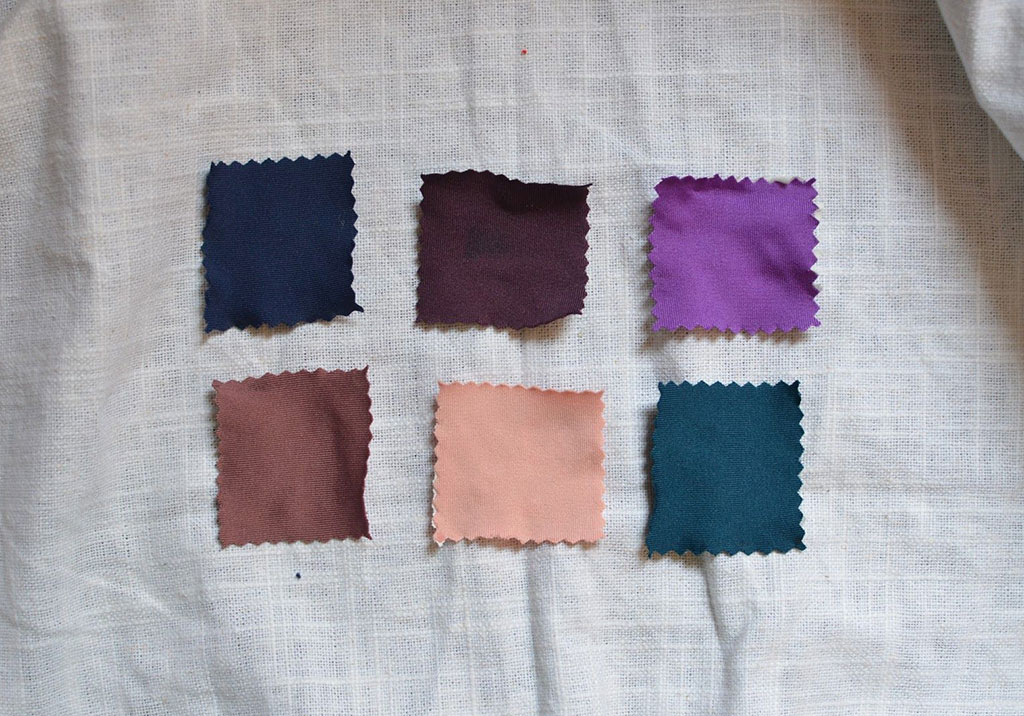
Find Your Colours
Whether you follow a seasonal method or stick to whatever colours you’re drawn to, head back to your original board and start to look for commonalities. Build on the previous section: so if you noticed, for example, that you gravitate towards boxy, canvas jackets, take note of whether you prefer them in pops of colour, or earthy neutrals. You may be a head-to-toe pastel person or a use-them-sparingly person. This is juicy material, and you’ll want to capture it all.
Tip: Pay special attention to how you feel about prints: do you prefer them scattered in small amounts amongst solids, or are you all about the print mixing-and-remixing?
Find Your Cut and Proportions
You know the drill. Head back to your original board, and start to look for similarities in cut and proportion. Do your favourite looks feature lots of short, cropped lines? This may present as colour blocking, crop tops/trousers, fittedness at the cuffs. Or do you gravitate towards long, flowing lines? Think long, floaty duster, monochromatic looks, or draped necklines.
Long, clean lines might be your bag, instead—think tailored suits, floor-sweeping bell bottoms, and long, unbroken lines of colour.
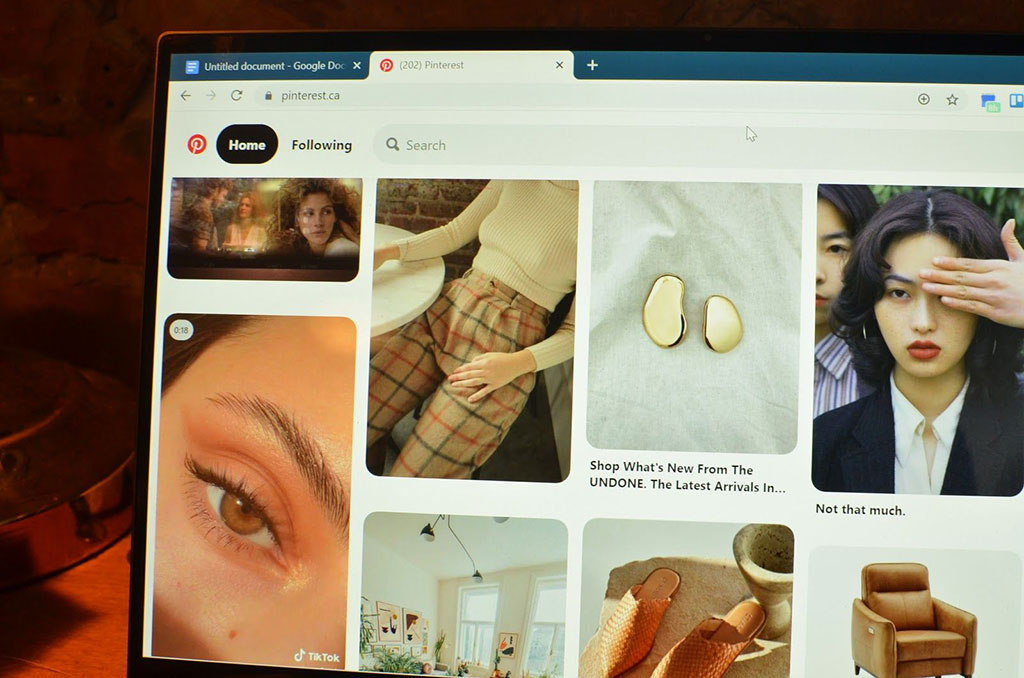
Styling inspiration can come from anything: the colour of a chair, or the organic shape of a pair of gold earrings.
Real World Styling
You’ve started to nail down what you gravitate towards at this point, but it’s no use if those notes won’t translate to your actual life. If you take photos of your makes or outfits, pull up those photos now—it’s easy if you’ve got an OOTD Instagram feed, but a photo folder will do the trick, too. Take a look at your notes, and pull any outfits from your personal collection that you feel work with your new guidelines over to your Pinterest board. Taking a look at how your style works IRL is a great opportunity to reassess any earlier notes, and make edits to your favourite cuts, fabrics and colours.
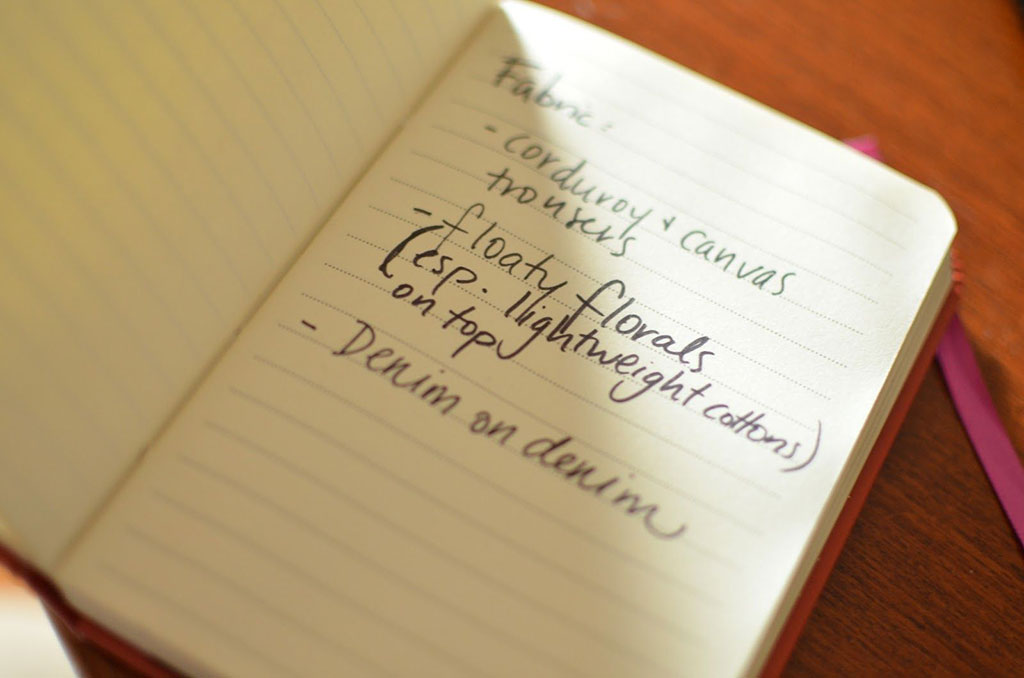
Give Your Style a job Title
Okay so if you’re anything like me, at this point you’ve got pages and pages of random notes and a brand-spankin’-new Pinterest board, but no idea about how to translate it all into a coherent style. I get it. I get it SO much that I wanted to share a little exercise that helped me bring all my eccentricities and style preferences together.
For the sake of discussion, here’s where I was at. I love bold, modern, minimal shapes (lantern sleeves! cocoon jackets! tent dresses!), but I also love to be playful with my outfits (bright colours! wild scarves! print clashing!). Giving your clothing a job title, much like a job title at an upstart company where you’re doing many disparate tasks under one umbrella, can help bring all the different aspects of your style “personality” together.
For example, mine is playful architect. That means for an outfit to feel like “me”, it must include some elements of modern minimalism (picture: the lead architect at an NYC firm) and some elements of playfulness (picture: high school art teacher). Lean too far one way, and it becomes too serious for me, and too far the other way and it veers kooky.
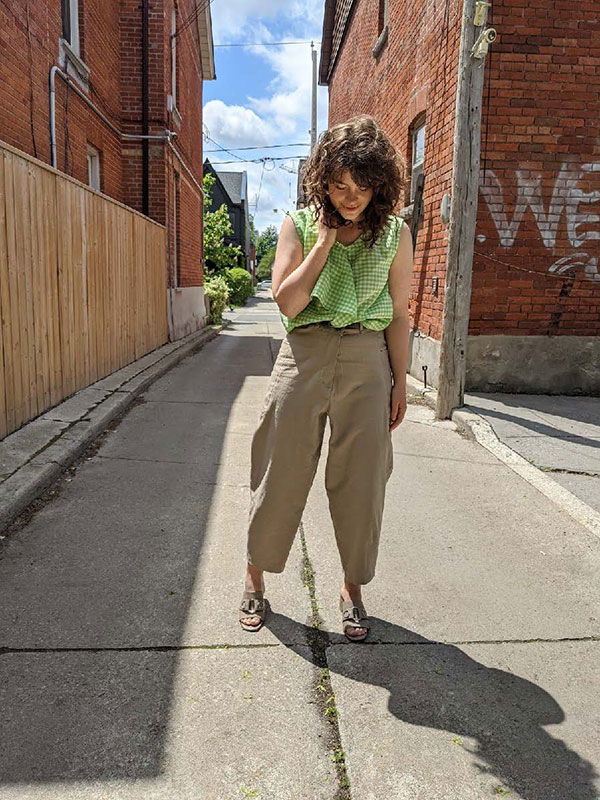
I’d say this look fits my “playful architect” style job title: the trousers feature minimal, modern shapes, and the ruffle and colour featured on the top contribute the playful element.
Try it yourself! List out a few adjectives that come to mind when looking over your notes and new inspiration board. Notice that some of your preferred looks are “romantic” (lots of lace, drawstrings and pouf), and some are “tailored” (crisp collars, fitted shoulders, stiffer fabrics)? Congrats, you’re hired for the role of “dreamy accountant.” Split in the middle between earthy, natural fibres and bright pops of neon? Your dream job: disco park ranger. Much like your daily tasks and responsibilities at your day job, your outfits should fulfill their “job description” as much as possible.
Go Pattern Window Shopping
Now that you’re armed with the priceless knowledge of your unique and personalized style description, open up a few new browser windows on some of your favourite pattern designers and companies’ websites. Oof, actually, you may want to open up a new window at this point: don’t want to crash your computer!
Browse through the patterns with your notes at hand, and see if there are any that fit with your notes. Once you’ve found your unicorn, take a look at the pattern’s recommended fabrics: with all luck, these will match up with some of your favourites listed in your notes, and you’ll have a very specific set of fabrics to shop for. This will help to narrow your focus, especially when bombarded with the temptation of fabric store newsletters and window displays.
Rule of Three Outfits
If you’ve only got five minutes, this is the most vital exercise you could do when thinking about sewing a new piece. Whatever you’re making, write down three outfits you can construct with that piece. Three outfits. That’s it. If you do this exercise for every single piece you make, over time, you’ll end up with a circular wardrobe of clothes that all complement each other.
It’s also a helpful exercise for planning future makes. Want to make something but can’t think of three outfits to wear it with? Think about the OTHER pieces you’d need to complete the outfit, and jot them down on a wishlist. Note if they keep coming up when you do this exercise. For example, if you want to make a gingham tank, but really need a pair of cargo pants to pair it with, jot it down in your wishlist. You may notice it comes up when you want to make a ruffled blouse or a bodysuit. That way, when planning your next make, cargo pants will be first on your list.
Shop your stash
The most sustainable fabric is the fabric you’ve already got. Before you hit the shops, take your narrowed-down shopping list to the fancy boutique that is your fabric shelf, and see if anything fits the bill.
Hot tip: Instead of organizing your stash by colour, try organizing by garment type. So say, in the above exercises, you found that you prefer trousers in stiffer fabrics like canvas and denim, and blouses in floaty fabrics like silk and lyocell. Group fabrics by preferred garment, and you’ll know exactly where to go once it’s time to sew a new piece.
Have fabric in your stash that doesn’t work with your current style? Consider turning it into a pillow, dog coat, napkins or a gift for a pal. Not the right weight? Consider it for a lining. Not the right colour? Try it away from your face, or as a colour block or lining. Still at a loss? Community fabric swaps are the best! Likewise, offer to send to an Instagram sewing pal for just the cost of shipping.
A Fabric Shopping Checklist
Phew. Okay. The moment we’ve all been waiting for. You’ve figured out your style preferences and narrowed down a pattern and fabric to shop for. No more exercises! No more boards! You know your preferences now, and you’ve got a narrowed down project and fabric list.
To make things easier, we created a short checklist for your fabric shopping needs—if it checks off most of these boxes, you can bet it’s a purchase you’ll immediately transform into a gorgeous garment you’ll adore for a long, long time.
Congrats! You’ve sorted out your personal style, and are well on your way to a lean stash stocked only with fabrics you adore. We’d suggest celebrating by pulling them all off the shelf and draping them lovingly around yourself like a fancy sewing princess or prince (after a really long nap—you deserve it).
